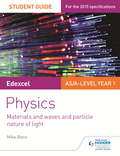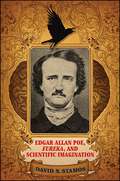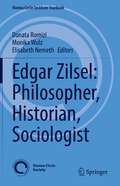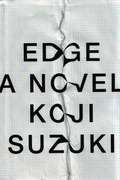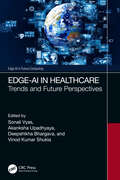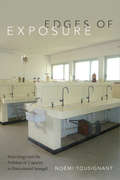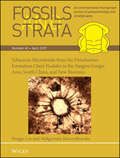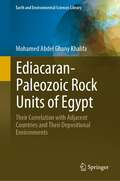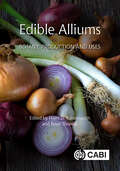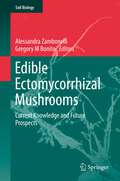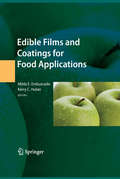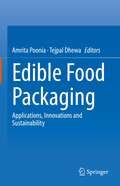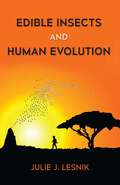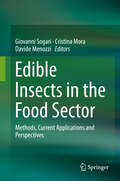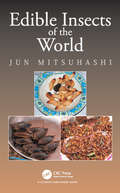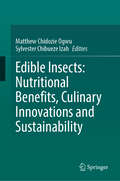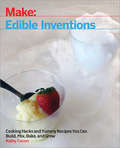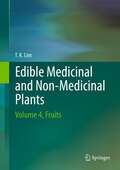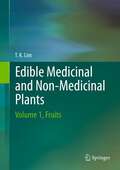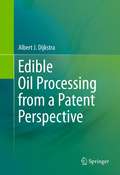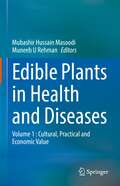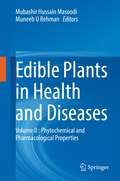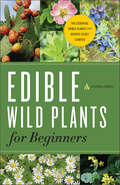- Table View
- List View
Edexcel Physics Student Guide 1: Topics 2 and 3
by Mike BennWritten by experienced teacher and author Mike Benn, this student guide for Physics:· Helps you identify what you need to know with a concise summary of the content examined in the AS and A-level specifications· Consolidates understanding with exam tips and knowledge check questions· Provides opportunities to improve exam technique with sample answers to exam-style questions· Develops independent learning and research skills · Provides the content for generating individual revision notes
Edexcel Physics Student Guide 2: Topics 4 and 5
by Mike BennWritten by experienced author and teacher, Mike Benn, this student guide for Physics:· Helps you identify what you need to know with a concise summary of the topics examined in the AS and A-level specifications· Consolidates understanding with exam tips and knowledge check questions· Provides opportunities to improve exam technique with sample answers to exam-style questions· Develops independent learning and research skills · Provides the content for generating individual revision notes
Edgar Allan Poe, Eureka, and Scientific Imagination
by David N. StamosSilver Winner, 2017 Foreword INDIES Book of the Year Awards in the Philosophy categoryIn 1848, almost a year and a half before Edgar Allan Poe died at the age of forty, his book Eureka was published. In it, he weaved together his scientific speculations about the universe with his own literary theory, theology, and philosophy of science. Although Poe himself considered it to be his magnum opus, Eureka has mostly been overlooked or underappreciated, sometimes even to the point of being thought an elaborate hoax. Remarkably, however, in Eureka Poe anticipated at least nine major theories and developments in twentieth-century science, including the Big Bang theory, multiverse theory, and the solution to Olbers' paradox. In this book—the first devoted specifically to Poe's science side—David N. Stamos, a philosopher of science, combines scientific background with analysis of Poe's life and work to highlight the creative and scientific achievements of this text. He examines Poe's literary theory, theology, and intellectual development, and then compares Poe's understanding of science with that of scientists and philosophers from his own time to the present. Next, Stamos pieces together and clarifies Poe's theory of scientific imagination, which he then attempts to update and defend by providing numerous case studies of eureka moments in modern science and by seeking insights from comparative biography and psychology, cognitive science, neuroscience, and evolution.
Edgar Zilsel: Philosopher, Historian, Sociologist (Vienna Circle Institute Yearbook #27)
by Elisabeth Nemeth Donata Romizi Monika WulzThis book provides a new all-round perspective on the life and work of Edgar Zilsel (1891-1944) as a philosopher, historian, and sociologist. He was close to the Vienna Circle and has been hitherto almost exclusively referred to in terms of the so-called “Zilsel thesis” on the origins of modern science. Much beyond this “thesis”, Zilsel’s brilliant work provides original insights on a broad number of topics, ranging from the philosophy of probability and statistics to the concept of “genius”, from the issues of scientific laws and theories to the sociological background of science and philosophy, and to the political analysis of the problems of his time. Praised by Herbert Feigl as an “outstanding brilliant mind”, Zilsel, being as a Social-Democrat of Jewish origins, mostly led a life of hardship marked by emigration and coming to a sudden and tragic end by suicide in 1944. The impossibility of an academic career has hindered the reception of Zilsel’s scientific work for a long time. This volume is a contribution to its late reception, providing new insights especially into his work during his years in Vienna; moreover, it shows the heuristic value of Zilsel’s ideas for future scholarly research – in philosophy, history, and sociology.
Edge
by Koji SuzukiEdge begins with a massive and catastrophic shifting of the San Andreas fault. The fears of California someday tumbling into the sea--that have become the stuff of parody--become real. But even the terror resulting from this catastrophe pales in comparison to the understanding behind its happening, a cataclysm extending beyond mankind's understanding of horror as it had previously been known. The world is falling apart because things are out of joint at the quantum level, about which of course there's never been any guarantee that everything has to remain stable.Koji Suzuki returns to the genre he's most famous for after many years of "not wanting to write any more horror." As expected from Suzuki, the chills are of a more cerebral, psychological sort, arguably more unsettling and scary than the slice-and-dice gore fests that horror has become known in the U.S. Never content to simply do "Suzuki"--as it were--but rather push the envelope on what horror is in general and for which readers have come to know him, Edge City borders on being cutting-edge science fiction. The author himself terms this novel, which he has worked on for some years, a work of "quantum horror."
Edge-AI in Healthcare: Trends and Future Perspectives (Edge AI in Future Computing)
by Sonali Vyas, Akanksha Upadhyaya, Deepshikha Bhargava, and Vinod Kumar ShuklaThe book provides comprehensive research ideas about Edge-AI technology that can assist doctors in making better data-driven decisions. It provides insights for improving the healthcare industry by examining future trends, simplifying decision making and investigating structured and unstructured data.Edge-AI in Healthcare: Trends and Future Perspective is more than a comprehensive introduction to Artificial Intelligence as a tool in healthcare data. The book is split into five chapters covering the entire healthcare ecosystem. First section is introduction to Edge-AI in healthcare. It discusses data usage, modelling and simulation techniques as well as machine and deep learning approaches. The second section discusses the implementation of edge AI for smart healthcare. The topics discussed in this section include, AR/VR and cloud computing, big data management, algorithms, optimization, and IoMT techniques and methods. Third section covers role of Edge-AI in healthcare and the challenges and opportunities of the technologies. This section also provides case studies and discusses sustainability, security, privacy, and trust related to Edge-AI in healthcare. This book is intended to benefit researchers, academics, industry professionals, R & D organizations and students working in the field of healthcare, healthcare informatics and their applications.
Edges of Exposure: Toxicology and the Problem of Capacity in Postcolonial Senegal (Experimental Futures)
by Noémi TousignantIn the industrialized nations of the global North, well-funded agencies like the CDC attend to citizens' health, monitoring and treating for toxic poisons like lead. How do the under-resourced nations of the global South meet such challenges? <P><P> In Edges of Exposure, Noémi Tousignant traces the work of toxicologists in Senegal as they have sought to warn of and remediate the presence of heavy metals and other poisons in their communities. Situating recent toxic scandals within histories of science and regulation in postcolonial Africa, Tousignant shows how decolonization and structural adjustment have impacted toxicity and toxicology research. <P>Ultimately, as Tousignant reveals, scientists' capacity to conduct research—as determined by material working conditions, levels of public investment, and their creative but not always successful efforts to make visible the harm of toxic poisons—affects their ability to keep equipment, labs, projects, and careers going.
Ediacaran Microfossils from the Doushantuo Formation Chert Nodules in the Yangtze Gorges Area, South China, and New Biozones (Fossils and Strata Monograph Series (PDF) #65)
by Pengju Liu Malgorzata MoczydlowskaEdiacaran-Paleozoic Rock Units of Egypt: Their Correlation with Adjacent Countries and Their Depositional Environments (Earth and Environmental Sciences Library)
by Mohamed Abdel KhalifaThis book presents the following geological contributions in Ediacaran and Paleozoic rocks. 1) It introduces four new rock units for the first time, the Ediacaran El Urf Formation (volcanoclastic sediments in the central Eastern Desert), the Ediacaran Abu Haswa Formation (stromatolitic dolostone in southwestern Sinai), the Early Permian Wadi Dome Formation (mixed clastics and carbonates in the west of Suez Gulf) and the Early Permian Misawag Formation (in the subsurface, northwestern Desert), 2) making correlation of the Ediacaran rock units with the corresponding rock units in Libya, Jordan, Iraq and Saudi Arabia, 3) linking the exposed Paleozoic rock units with their equivalent rock units in subsurface in northwestern desert, 4) correlating the Paleozoic rock units with the equivalent rock units in adjacent countries, e. g. Libya, Jordan, Iraq and Saudi Arabia, 5) manifesting the possible depositional environments of the Ediacaran and Paleozoic rock units. Additionally, it offers an important unique geological information about the Ediacaran and Paleozoic rock units in Egypt. It unifies the nomenclature of Paleozoic rock units that take numerous names for the same geological time. It obsoletes the formation names that do not follow the rules of the North American stratigraphic code (1983) for rock units’ nomenclature. It provides the target audience illustrations, e.g. field photographs for the exposed rock units that save efforts and time for audience (undergraduate, post-graduate, researchers and professional) to reach to the original localities of each rock units. It provides the audience with schematic diagrams that exhibit the link between the exposed and subsurface rock units all over the Egyptian territory. It describes the following topics of each rock unit: definition, stratigraphic contact, lithological characteristics, faunal and floral associations that are used for the identification of the possible age, correlation with corresponding rock units in adjacent countries, e.g. Libya, Jordan, Iraq and Saudi Arabia and the possible depositional environments for each rock units. The book is a fundamental source of an updated version of the information in the field to the undergraduate, graduate, researchers, professional, practitioners and policy planning elsewhere.
Edible Alliums: Botany, Production and Uses (Botany, Production and Uses)
by Brian Thomas Haim D. RabinowitchAllium crops include more than 30 species, many of which (for e.g. onions, shallots, garlic, leeks, bunching onions, and chives) are of economic importance. Bulb onions rank second only to tomatoes in terms of global production. Alliums are farmed and harvested in a range of climatic conditions worldwide, forming important parts of local diets. This book provides a comprehensive review of major and minor Allium crops from scientific and horticultural perspectives. It broadly covers modern biology (including genetics and breeding), propagation, production, processing, and nutritional and health benefits. Edible Alliums contains coverage of: Both major and minor Allium crops. Improving crop production, quality, and sustainability of Allium crops. Advances in digital technologies, 'omics' research and gene editing. Objectives for improving crop performance, such as integrated crop management, the plant-soil interface, improving propagation materials, post-harvest quality and reducing waste. This is an essential resource for scholars, researchers and students in plant science and agriculture, in addition to molecular biologists, plant breeders, agronomists, consultants, and extension specialists.
Edible Ectomycorrhizal Mushrooms
by Alessandra Zambonelli Gregory M BonitoEdible ectomycorrhizal mushrooms (EEMMs) comprise more than 1000 species and are an important food and forest resource. In this volume of Soil Biology, internationally recognized scientists offer their most recent research findings on these beguiling fungi. Topics covered include: complex ecological interactions between plants, EEMMs, and soil organisms; comparative genomics, high-throughput sequencing and modern research tools; genetic selection of fungal strains and techniques for inoculating plants; economic and social considerations surrounding wild collected EEMMs; and practical information concerning soil management and EEMM cultivation. The book will be a useful guide for anyone interested in soil ecology, forestry, or the genetics and cultivation of EEMMs, and provides an extensive knowledge base and inspirations for future studies on these ecologically and economically important fungi.
Edible Films and Coatings for Food Applications
by Milda E. Embuscado Kerry C. HuberEdible films and coatings play an important role in the quality, safety, transportation, storage, and display of a wide range of fresh and processed foods. Edible films and coatings, while preventing moisture loss and maintaining quality, prevent spoilage and microbial contamination of foods. The edible film and coating industry is now a multimillion dollar industry. Less than $1 million in 1999, the market has grown to more than $100 million and is expected to grow to $350 million by 2008, according to James Rossman of Rossman Consulting. Pharmaceutical and consumer products have been responsible for the tremendous increase. This growth has produced an enormous amount of scientific articles, patents, and research projects undertaken by members of the food industry, academia, and research institutions. Edible Films and Coatings for Food Applications brings together this vast wealth of scientific knowledge in a systematically organized volume. It examines the science, application, function, and market for edible films and coatings.
Edible Food Packaging: Applications, Innovations and Sustainability
by Amrita Poonia Tejpal DhewaThis book discusses the various aspects of sustainable packaging edibles in food industry. It is divided into five main parts. The first section of the book addresses details of edible films, various sources, origin, scope and functions. Second section covers different sustainable alternatives such as seed gums, fruits and vegetable peels, sea weeds, fruits wastes, dairy by products & anti-oxidant edible packaging. This book also discusses about methods of improvements of mechanical properties of packaging edibles & their food applications, testing methods, innovations, limitations, challenges and nano edibles. It provides insights about the large quantity of wastes and by-products generated by food processing industries. Disposal of these wastes is a big problem due to their high biochemical oxygen demand (BOD) & chemical oxygen demand (COD) which causes severe problem of pollution to the environment. These wastes contain large amounts of proteins, carbohydrates, lipids, minerals, various bioactive compounds and have eco-friendly packaging potential. The book emphasizes on the fact that recycling these wastes as packaging edibles are sustainable and economical. As a world foreseeing food technology revolution, this book explores the unique topics in food packaging which possesses mammoth commercial applications and environmental potential. Due to its immense scope, this book is highly useful for researchers, food scientists, students and food packaging industry experts.
Edible Insects and Human Evolution
by Julie J. LesnikResearchers who study ancient human diets tend to focus on meat eating because the practice of butchery is very apparent in the archaeological record. In this volume, Julie Lesnik highlights a different food source, tracing evidence that humans and their hominin ancestors also consumed insects throughout the entire course of human evolution. Lesnik combines primatology, sociocultural anthropology, reproductive physiology, and paleoanthropology to examine the role of insects in the diets of hunter-gatherers and our nonhuman primate cousins. She posits that women would likely spend more time foraging for and eating insects than men, arguing that this pattern is important to note because women are too often ignored in reconstructions of ancient human behavior. Because of the abundance of insects and the low risk of acquiring them, insects were a reliable food source that mothers used to feed their families over the past five million years. Although they are consumed worldwide to this day, insects are not usually considered food in Western societies. Tying together ancient history with our modern lives, Lesnik points out that insects are highly nutritious and a very sustainable protein alternative. She believes that if we accept that edible insects are a part of the human legacy, we may have new conversations about what is good to eat—both in past diets and for the future of food.
Edible Insects in the Food Sector: Methods, Current Applications and Perspectives
by Giovanni Sogari Cristina Mora Davide MenozziThis book explores one of the most discussed and investigated novel foods in recent years: edible insects. The increasing demand for alternative protein sources worldwide had led the Food and Agriculture Organization of the United Nations (FAO) to promote the potential of using insects both for feed and food, establishing a program called “Edible Insects.” Although several social, environmental, and nutritional benefits of the use of insects in the human diet have been identified, the majority of the population in Western countries rejects the idea of adopting insects as food, predominantly for cultural reasons. Nevertheless, international interest in promoting the consumption of insects has grown significantly, mainly in North America and Europe. This trend is mostly due to increasing attention and involvement from the scientific network and the food and feed industries, as well as governments and their constituents. The book explores the current state of entomophagy and identifies knowledge gaps to inform primary research institutions, students, members of the private sector, and policymakers to better plan, develop, and implement future research studies on edible insects as a sustainable source of food. The case studies and issues presented in this book cover highly up-to-date topics such as aspects of safety and allergies for human consumption, final meat quality of animals fed with insects, the legislative framework for the commercialization of this novel food, and other relevant issues.
Edible Insects of the World
by Jun MitsuhashiThe first book on entomophagy written in this manner, Edible Insects of the World is an enumeration of 2,141 species of edible insects. For the reader’s convenience, insect names are arranged much like a dictionary, first by taxonomic group and then by country. In addition to taxonomic and location information, entries contain applicable details about the history of entomophagy, collecting, cooking, and medicinal uses.
Edible Insects: Nutritional Benefits, Culinary Innovations and Sustainability
by Sylvester Chibueze Izah Matthew Chidozie OgwuInsects have been consumed by various cultures across the globe for centuries, yet their potential as a sustainable and nutritious food source has only recently gained widespread attention. As the global population edges toward nine billion, securing sustainable protein sources that balance environmental, economic, and nutritional needs is paramount. Edible insects offer a promising solution that aligns with global sustainability goals, particularly in the context of climate resilience, circular economy, and alternative protein markets. Edible Insects: Nutritional Benefits, Culinary Innovations and Sustainability provides a comprehensive exploration of the diverse roles insects play in global food systems. The book highlights the nutritional composition of edible insect species, their functional health benefits, and their critical role in addressing food security and malnutrition. It also showcases how insects are being integrated into modern cuisines, innovative food products, and alternative protein markets through cutting-edge research and product development efforts. The book also emphasizes the sustainability aspects of insect farming, particularly its low environmental footprint compared to conventional livestock production. Across 16 chapters, expert contributors from various disciplines and regions examine topics ranging from cultural significance, regulatory challenges, and consumer acceptance to the future potential of insect-based foods in mainstream diets. This holistic volume is essential reading for researchers, food industry professionals, policymakers, and sustainability advocates interested in unlocking the full potential of edible insects for a more resilient global food system.
Edible Inventions: Cooking Hacks and Yummy Recipes You Can Build, Mix, Bake, and Grow
by Kathy CeceriBelieve it or not, there's a lot of inventing going on in the kitchen. Unless you only eat fruits and veggies right off the plant, you are using tools and techniques invented by humans to make food more tasty and easier to digest. When you cook food, you start to break it down into a form your body can absorb. When you add chemicals to make it thicker, gooey-er, or puffy-er, you turn a bunch of boring ingredients into a mouth-watering snack. Edible Inventions: Cooking Hacks and Yummy Recipes You Can Build, Mix, Bake, and Grow will show you some unusual ways to create a meal, and help you invent some of your own. Projects include:3D printing with foodChemical cuisine and molecular gastronomyPrepared foods like jellies and pickles at homeGrowing your own ingredientsCooking off the grid
Edible Medicinal And Non Medicinal Plants
by Lim T. K.This book continues as volume 3 of a multi-compendium on Edible Medicinal and Non-Medicinal Plants. It covers edible fruits/seeds used fresh or processed, as vegetables, spices, stimulants, edible oils and beverages. It encompasses species from the following families: Ginkgoaceae, Gnetaceae, Juglandaceae, Lauraceae, Lecythidaceae, Magnoliaceae, Malpighiaceae, Malvaceae, Marantaceae, Meliaceae, Moraceae, Moringaceae, Muntigiaceae, Musaceae, Myristicaceae and Myrtaceae. This work will be of significant interest to scientists, researchers, medical practitioners, pharmacologists, ethnobotanists, horticulturists, food nutritionists, agriculturists, botanists, conservationists, lecturers, students and the general public. Topics covered include: taxonomy; common/English and vernacular names; origin and distribution; agroecology; edible plant parts and uses; botany; nutritive and pharmacological properties, medicinal uses and research findings; nonedible uses; and selected references.
Edible Medicinal And Non-Medicinal Plants
by T. K. LimThis book continues as volume 4 of a multi-compendium on Edible Medicinal and Non-Medicinal Plants. It covers edible fruits/seeds used fresh or processed, as vegetables, spices, stimulants, edible oils and beverages. It encompasses selected species from the following families: Fagaceae, Grossulariaceae, Hypoxidaxeae, Myrsinaceae Olacaceae, Oleaceae, Orchidaceae, Oxalidaceae, Pandanaceae, Passifloraceae, Pedaliaceae, Phyllanthaceae, Pinaceae, Piperaceae, Rosaceae and Rutaceae . This work will be of significant interest to scientists, researchers, medical practitioners, pharmacologists, ethnobotanists, horticulturists, food nutritionists, agriculturists, botanists, conservationists, lecturers, students and the general public. Topics covered include: taxonomy; common/English and vernacular names; origin and distribution; agroecology; edible plant parts and uses; botany; nutritive and pharmacological properties, medicinal uses and research findings; nonedible uses; and selected references.
Edible Medicinal and Non-Medicinal Plants: Volume 1, Fruits
by Lim T. K.This multi-compendium is a comprehensive, illustrated and scientifically up-to-date work covering more than a thousand species of edible medicinal and non-medicinal plants. This work will be of significant interest to scientists, researchers, medical practitioners, pharmacologists, ethnobotanists, horticulturists, food nutritionists, agriculturists, botanists, herbalogists, conservationists, teachers, lecturers, students and the general public. Topics covered include: taxonomy (botanical name and synonyms); common English and vernacular names; origin and distribution; agro-ecological requirements; edible plant part and uses; botany; nutritive and medicinal/pharmacological properties, medicinal uses and current research findings; non-edible uses; and selected/cited references. Each volume covers about a hundred species arranged according to families and species. Each volume has separate scientific and common names indices and separate scientific and medical glossaries.
Edible Oil Processing from a Patent Perspective
by Albert J. DijkstraPatent literature has always been a mine of information, but until recently, it was difficult to access. Now, with the Internet, access to all patent documents is almost instantaneous and free. However, interpreting the technical information provided by patent literature requires a certain skill. This monograph aims to provide that skill by explaining patent jargon and providing background information on patenting. Patents dealing with edible oil processing are used to explain various aspects of patenting. To make the explanations less impersonal, some have been larded with personal remarks and experiences. Accordingly, this monograph is intended for scientists and engineers dealing with edible oils and fats who want to extend their sources of technical information. Hopefully, it will inspire them to innovate, help them to avoid duplication, and provide them with some amusement.
Edible Plants in Health and Diseases: Volume 1 : Cultural, Practical and Economic Value
by Mubashir Hussain Masoodi Muneeb U RehmanThe book provides significant information on some of the promising edible medicinal plants and how these possess both nutritive as well as medicinal value. The significance of these edible plants in traditional medicine, their distribution in different regions and the importance of their chemical constituents are discussed systematically concerning the role of these plants in ethnomedicine in different regions of the world. The current volume focuses on the economic and culturally important medicinal uses of edible plants and a detailed survey of the literature on scientific researches of pharmacognostical characteristics, traditional uses, scientific validation, and phytochemical composition, and pharmacological activities. This book is a single-source scientific reference to explore the specific factors that contribute to these potential health benefits, as well as discussing how to maximize those potential benefits. Chemists, food technologists, pharmacologists, phytochemists as well as all professionals involved with quality control and standardization will find in this book a valuable and updated basis for their work.
Edible Plants in Health and Diseases: Volume II : Phytochemical and Pharmacological Properties
by Mubashir Hussain Masoodi Muneeb U RehmanThe book provides essential information on some of the promising edible medicinal plants and how these possess both nutritional as well as therapeutic value. The significance of the edible plants in traditional medicine and the importance of the distribution of their chemical constituents are discussed systematically concerning the role of these plants in ethnomedicine in different regions of the world. The current volume deals with the individual plants' phytochemical and pharmacological properties, emphasizing human health. The title would demonstrate the value of natural edible plants and introduce readers to state-of-the-art developments and trends in omics-driven research. This book is a single-source scientific reference to explore the specific factors that contribute to these potential health benefits and discuss how to maximize those potential benefits. Chemists, food technologists, pharmacologists, phytochemists, and all professionals involved with quality control and standardization will find in this book a valuable and updated basis for their work.
Edible Wild Plants for Beginners: The Essential Edible Plants and Recipes to Get Started
by Althea PressDig up a whole new culinary world with this New York Times best-selling field guide to foragingMost of us "forage" for food in the aisles of well-lit grocery stores. But there are delicious edible plants for the taking right outside your door! This all-in-one reference shows you how to identify 31 of the most common edible wild plants in North America, from California to Connecticut.Gather your gear—Dive into edible plant history and foraging FAQs, and learn what tools you'll need before you head out.Spot the snacks—Find photos, descriptions, distinguishing characteristics, and common uses for 31 edible wild plants—from arrowroot to wild rose.Recipes and remedies—Learn to use wild plants in everything from curry and cookies to bug bite balm and bath soaks.Stay safe—This book includes foraging guidelines that are vital to your safety. It's recommended you read it in its entirety before you explore.Make the most of what Mother Nature has to offer with Edible Wild Plants for Beginners.

